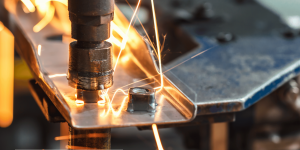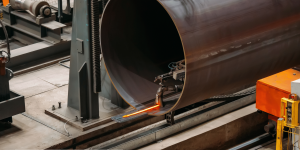Welding is a fabrication process that uses heat to melt the materials to be joined and then solidify them. Welding is a process that involves joining two or more pieces of metal or thermoplastics to form a single structure. Several categories of welds are used depending on the intended application.
There are two main types of resistance welds: spot welds and tack welds. Although both contribute to forming a solid joint, there are slight differences between the two.
A Spot Weld is defined as:
A spot weld or resistance spot weld, on the other hand, is a joining process that involves the connection of two or more metal sheets at a single point by heat and pressure. Electric current and force are used to produce heat and melt metals at the spot where the two metal sheets come into contact with the electrodes. The pressure thus guarantees a strong interaction occurs when the metal is cold.
Characteristics of Spot Welds
– Make consolidation of join sheets at a tiny place
– Produced by resistance heating
– A disadvantage is that this technology requires access to both sides of metal sheets.
– Fused area small, circular on the surface
– Usually produced by spot welding machine with water-cooled electrodes
– Primarily utilized in overlapping thin gage sheet metals
– Welds are narrow, ranging from a few millimetres up to 1 cm in width
– Strength is determined by the number and size of spot welds.

Spot welding is one of the most common welding types employed in industries today. Resistance spot welding is widely used in the automotive industry to connect car structures and body parts. When several spot welds are made at small intervals, solid and continuous welds are formed along the joint interface through thin sheets of steel or aluminium.
Tack weld is a welding process used mainly to join similar materials.
A tack weld, also described as a tack fusion weld, is a small weld that is made to hold two pieces of metal in place temporarily. Tacking offers sufficient strength to keep the metals in place and the correct position, as the final joining is done through welding.
Characteristics of Tack Welds
– Two components being connected are temporarily bonded
– Most of the time, it is done using a handheld welding gun.
– Very fast – may be completed within a few seconds.
– It can only partially enter materials
– Small size that is not more than 2. 5 cm long.
– It is easy to prepare without using many tools.
– Used when welding is done in intervals before applying the finishing touches.
– Can be taken off as quickly if the need arises.
Tack welds can be used in cases where large metal structures have to be constructed. They allow for correct orientation of parts so that alignment is not compromised in the welding process. Tacking also helps prevent warping and distortion before setting the final and permanent welds.
Key Differences Between Methods
While spot and tack weld both fuse materials together, there are some essential ways in which they vary:
Size of the Weld
– Spot welds are small, rounded disks of two metals that are fused and are usually less than 1 cm in diameter. Tack welds are longer and can be 1 to 2. 5 cm long.
Weld Penetration
– Spot welds produce a bond between both sheets of metal in the welded area and extend through the thickness of each sheet. Tack welds do not penetrate the metal or through it but are usually used to check whether a joint will come out right.
Purpose
– Spot welding produces a solid and permanent connection. Tacking brings two pieces of parts that are to be joined together temporarily.
Production Rate
– In fact, spot welding machines are capable of delivering hundreds of welds per minute and sometimes even more. Tack welds are deposited manually at a slower rate than the regular welding process.
Removability
– In spot welds, two parts join permanently, while in tack welds, these two parts can be separated quite easily.
Machinery
– Spot welding is expensive and needs special equipment with water-cooled electrodes. The tack welds are made using ordinary welding guns and other materials that are cheap.
Metal Thickness
– Spot welding is mainly used on metals that are thin and have a thickness of not more than 3 millimeters. Tack welding can join thicker stock.
Industry Usage
– Spot welding is widely used in mass production industries, such as automotive production. Tack welding is used in fabrication shops and in construction activities.
Quality Control
– Several spot welds are made and placed in equal intervals to help provide stability. Thus, the number and location of tack welds may differ significantly.
When to Use Each Method
There are certain situations where a spot weld is the preferred choice, and times when using a tack weld works better:
When to Spot Weld
– Welding thin gauge sheet metal up to 3mm thick
– Mass production environment
– Joint seams and flanges that need long-term permanent sealant connections
– Spheres of activity where muscle power and tight sealing are of paramount importance

When to Tack Weld
– Thicker metal stock over 3 mm gauge
– Big welded structures where probably some sort of alignment must be kept
– There are bonds that may require to be detached later to facilitate certain modifications.
– Temporary fasteners to hold parts in place until final welding process.
Conclusion
Spot welding and tack welding are critical in joining metals that are essential in the manufacturing processes. Different techniques have certain features and can be used in specific conditions. Spot welding quickly joins thin metal sheets while tack welding temporarily aligns thicker metals to be joined. This understanding helps in choosing the appropriate technique to use in different welding processes. Both spot and tack welds when applied singly or in combination yield accurate assembly and quality finished goods.
